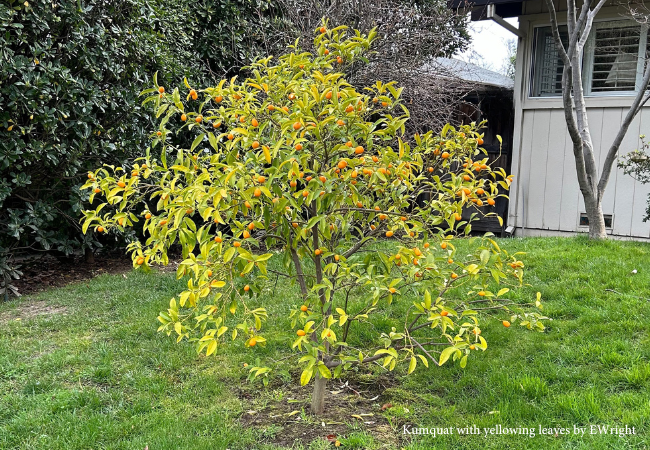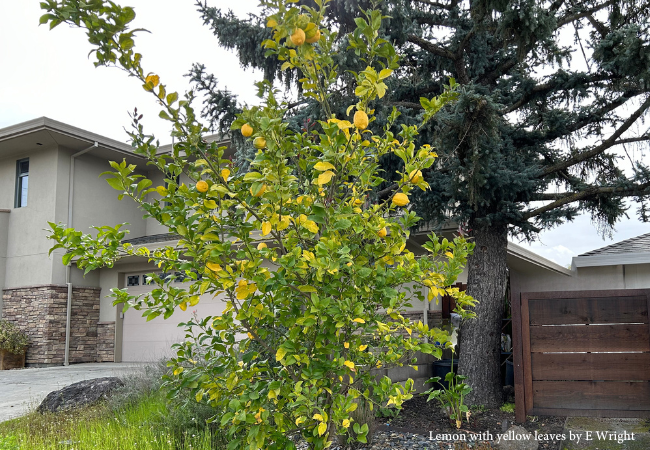Help! My lemon tree has yellowing leaves and is dropping leaves… that is one of the most frequent requests we get at the Help Desk, especially in late winter and early spring.
When we see yellowing leaves on citrus, often we leap to the conclusion that it is nitrogen or iron deficiency. There are many causes of yellowing of leaves, not just nitrogen deficiency or iron deficiency. Some of the reasons for the yellowing of leaves will take care of themselves if we are patient and we wait for the soils to warm and dry as we emerge from winter temperatures and winter rains.
Yellowing leaves and leaf drop in citrus often occur in winter.
Winter leaf drop is part of the natural cycle of eliminating old leaves and their replacement with new leaves. Citrus sheds leaves year-round; the older leaves drop off, but in winter there are no new leaves to replace them.
Citrus often “rest” in winter, meaning no growth of new leaves, stems or roots. Citrus trees are evergreen tropical plants that are grown in subtropical regions; in winter, they go into a “quiescent” state, a kind of dormancy for subtropical trees. This is a kind of resting phase that is somewhat protective against frost. The winter temperatures are too low in many citrus-growing areas of California for vegetative growth, the growth of leaves, stems and roots.
The “winter yellows” are the yellowing of citrus leaves during the winter. The yellowing is most common on the later summer flush leaves, the leaves produced during the summer. Symptoms of winter yellows can include leaves that are pale all over with the older leaves often being affected first. The symptoms of winter yellows look like nitrogen deficiency, but the yellowing in winter likely is not due to the lack of nitrogen in the soil. Cool weather inhibits nutrient uptake, and then the leaves look as though there is a nutrient deficiency; however, if you tested the soil, the tests might show sufficient nutrients such as nitrogen or iron.
Root activity slows or stops when soil temperatures are low and soil is waterlogged. Leaf yellowing and drop in the winter is more likely due to excessive or too little water in the root zone or dry winds in combination with cool soils. Winds can cause more leaves to drop sooner, making it seem that there is more of a problem since the branches look more bare. Winter yellows can be more severe when we have winter rains that seem to come storm after storm, and the root zones become waterlogged. Soils that are too cold or wet do not allow the roots to absorb nutrients. Adding nutrients like nitrogen and iron during winter won't address the causes of winter yellowing of leaves.
Low temperatures hinder microbial activity that makes nitrogen more plant-accessible.

Cool soil temperatures inhibit microbial activity that is important to the processes of mineralization and nitrification, essential in the conversion of nitrogen to forms more accessible to plants.
- Mineralization is how microbes convert organic nitrogen to ammonium, an inorganic form of nitrogen which plants can absorb directly from the soil. Mineralization readily occurs in warm (68-95 degrees Fahrenheit), well-aerated and moist soils.
- Nitrification is how microbes convert ammonium to nitrate to get energy. Nitrate is the most plant-available form of nitrogen, but it is also the most susceptible to being lost to the plants due to leaching, which is when nutrients wash away in excess water. Nitrification is most rapid when soil temperature is between 67 to 86 degrees Fahrenheit but essentially stops when temperatures are below 41°F and above 122°F.
Want to measure your soil temperature? If you are curious whether the soil temperatures have reached the high sixties where the microbes are most efficient at making nitrogen accessible, you can use an instant-read probe, like the ones used for cooking or ones for soil. Insert the probe to the depth of the roots of the citrus. Test in the early morning for the lowest temperatures.
As temperatures warm up and as topsoil warms and drains, the trees generally gradually recover and the foliage re-greens. Look for the first flush of new growth in the spring. Healthy new leaves indicate a healthy tree, and your tree doesn't need additional nutrients right now.
This blog post is brought to you by the Help Desk of the Master Gardeners of Alameda County. Subscribe to our blog!
Have a gardening question? We'll help. You can reach us by:
- Emailing acmg@ucanr.edu. Please include a photo of the problem, if you can, plus your name, phone number, city and a description of the problem.
- Using our online form.
- By phone, during our office hours, 10 am to noon Wednesday and 11 am to 1 pm Thursday: 510-670-5645. At other times, please leave a message and we'll return your call during our office hours.
- In person at our Hayward office, during our office hours, only by appointment.
Resources
- Winter Yellows - Ben Faber
- Leaves on your Citrus Trees Turning Yellow this Winter? Don't Panic. by Ed Perry, emeritus Environmental
- Horticultural Advisor for University of California Cooperative Extension (UCCE) in Stanislaus County.
- Fertilizing Citrus in the Foothills
- Nitrogen Basics – The Nitrogen Cycle
- Nitrogen deficiency
- Nitrogen Management in Citrus and Avocado
